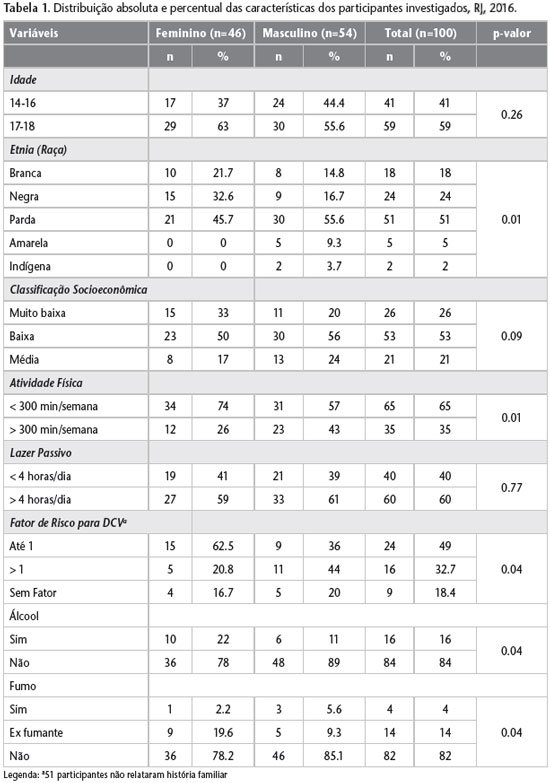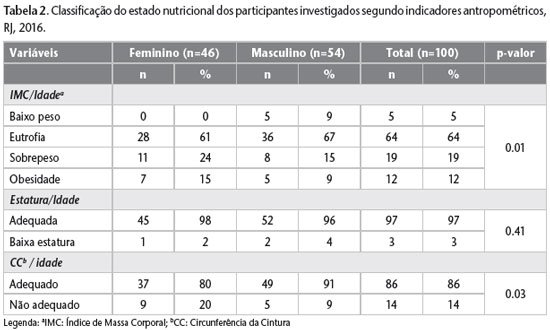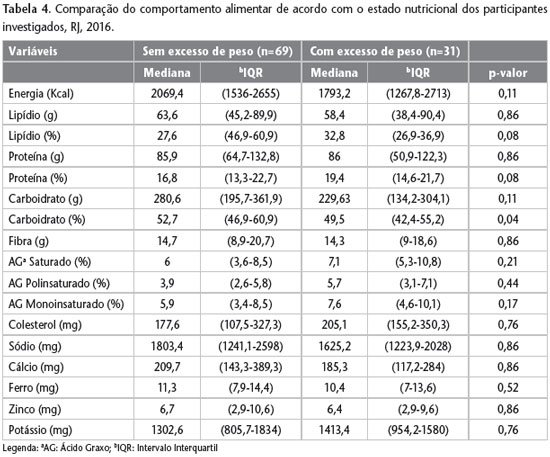INTRODUCTION
Cardiovascular diseases (CVD) are considered the main causes of death in Brazil, where 4.2% of the population (6.1 million people) aged 18 or over were diagnosed with some kind of heart disease in 2013
1 . Although most clinical manifestations appear in adulthood, it has been found that excess weight, sedentary lifestyle, poor diet, and alcohol and tobacco use are risk factors (RF) that are increasingly manifesting earlier in childhood and adolescence
2 in our country, due to changes in the population’s lifestyle and eating habits.
The current nutritional scenario contributes to the epidemic of obesity and other chronic diseases that already affect all age groups, including adolescents. Excessive consumption of ultra-processed foods, rich in fat, sodium and simple sugars, skipping or replacing meals with snacks (
fast foods ), low consumption of natural foods (fruits and vegetables) and culinary preparations that value regional aspects are some examples of this scenario
3 . Globalization, urbanization and the lack of control over commercial food advertising may be contributing to accelerating this process.
In addition to diet, other RFs such as sedentary lifestyle and inadequate lifestyle are increasingly present in children. Data from the National School Health Survey
4 (PeNSE) conducted in 2015 revealed that approximately 60.8% of adolescents were classified as insufficiently active and 4.8% as inactive, mainly associated with the increase in passive leisure (number of hours spent in front of the television and internet). Regarding inadequate habits, 19.6% have tried smoking and 26.1% use or have used alcoholic beverages
5 .
From the above, it is clear that currently, the pediatric population is already at risk of developing plurimetabolic syndrome (obesity, hypertension, diabetes mellitus and dyslipidemia) and cardiovascular disease, highlighting the importance of early diagnosis and prevention strategies
2 . Thus, this study aimed to evaluate the quality of the diet and the prevalence of risk factors for cardiovascular disease in adolescent schoolchildren.
METHODS
This is a descriptive, cross-sectional, prospective study, whose population base consisted of 100 adolescents (14-18 years old), of both sexes, enrolled in a public school located in the city of Rio de Janeiro. Only students whose guardians or students over 18 years of age signed the informed consent form (ICF) and the Assent Form participated in this study. This study was approved by the Research Ethics Committee of the Oswaldo Cruz Foundation (Opinion No. 1,610,816).
The research was conducted using a standardized protocol with open and closed questions in which the following information was collected from the participants: anthropometric, dietary, socioeconomic, social data and blood pressure.
To assess the nutritional status of the adolescents, weight (kg), height (m) and waist circumference (cm) were measured. Based on these data, the anthropometric indices were calculated: Body Mass Index (BMI = Weight/Height²) by age (BMI/A) and height by age (H/A). The classification of nutritional status followed the classification recommended by the Food and Nutrition Surveillance System (SISVAN)
5 , a reference adopted by the World Health Organization in 2007. The cutoff point of the 90th percentile was adopted for the classification of waist circumference (WC)
6 .
Qualitative and quantitative data on the adolescents’ eating behavior were assessed through a 24-hour recall, in which the consumption of macronutrients, micronutrients, fractions of total fat and fiber were calculated with the aid of the
Avanutri Revolution ® program . The assessment of the adequacy of macronutrients and micronutrients was performed according to the dietary reference intake (DRI). To analyze habitual sodium intake, a food frequency questionnaire with foods rich in sodium (QFARS) was applied, based on the study by Manfroi (2009)
7 , which consists of 26 food items and the frequency can be described as 0 to 10 times and with the time unit varying in day, week, month and year.
The assessment of the students’ lifestyle was carried out using information obtained regarding physical activity, sedentary habits, family history, smoking and alcohol consumption. Those who exercised physical activity more than 300 minutes per week were classified as sufficiently active
8 . Regarding passive leisure habits (hours in front of the TV, computer and videograms), sedentary behavior was considered risky when the time was greater than or equal to 4 hours/day
9. Regarding cigarettes, students were asked whether they currently smoked, whether they had stopped smoking, or whether they had only experimented. They were also asked about alcohol intake, its quantity, and frequency.
When measuring blood pressure levels, adolescents with blood pressure values below the 90th percentile were classified as normotensive, borderline when values were between the 90th and 95th percentiles, and hypertensive when the value was equal to or greater than the 95th percentile
10 .
All analyses were performed using
SPSS version 22.0. Descriptive analyses included calculations of proportions, mean, and standard deviation (SD). The chi-square test was used to compare the prevalence of cardiovascular risk factors by gender or nutritional status.
RESULTS
The initial study sample consisted of 126 adolescents. After recruitment, there were dropouts and/or refusals (n=26; 3.2%), totaling 100 adolescents with a mean age of 16.9 ± years for final data analysis.
According to Table 1, it can be seen that most of the participants were male, brown, of low socioeconomic status, sedentary and had at least one RF in the family history (FH) for CVD. It was found that the majority of FH were positive for hypertension (29%), diabetes (20%) and obesity (9%). Regarding lifestyle, it was observed that experimentation with alcoholic beverages (p=0.04) and tobacco (p=0.04) among adolescents was more prevalent in females.

When assessing gender, it was noted that females had a higher percentage of physical inactivity, excess weight and high waist circumference when compared to males (Table 2). And although 60% of the population investigated had passive leisure above the recommended level (>4 hours per day), there was no difference between the sexes. Regarding blood pressure, it was possible to observe that 32% of the adolescents investigated presented alterations in systolic blood pressure levels, being more prevalent in females (p=0.03) (Table 3).


When investigating the risk of developing metabolic syndrome (MS) among the participants, it was observed that 3% of the adolescents presented concomitant factors such as: excess abdominal fat and high blood pressure.
Regarding the eating behavior of the participants, the presence of inadequate eating habits was observed both from a qualitative and quantitative point of view.
Among the dietary items investigated, it was found that the students had a high average protein intake (1.7g/kg/day), a low intake of fiber (<20g/day) and calcium (<1000mg/day) in both sexes. In addition, the median usual sodium intake among the adolescents was 1730.9 mg. It is important to highlight that the adolescents reported weekly consumption of industrialized seasonings (70%), instant noodles (79%) and soft drinks (95%). Low consumption of fruits and vegetables was also observed, contributing to the dietary profile presented. Regarding the lipid profile of the diet, it was found that 27.2% of the adolescents had a dietary cholesterol consumption higher than 300 mg/day, and a low consumption of monounsaturated fat (80%), with a greater predominance among boys (p=0.01).
When comparing the dietary consumption between eutrophic and overweight adolescents, it was observed that there was only a statistical difference in the percentage of carbohydrate obtained from the total caloric value of the diet (p=0.03) (Table 4). When analyzing the consumption between genders, it was found that boys had a higher energy (p=0.01), lipid (p=0.01), iron (p<0.01) and zinc (p=0.03) consumption.

Regarding micronutrient intake, inadequacies were also found in the population studied. The average daily intake of calcium and potassium was only 335.16 mg and 1369 mg, respectively, demonstrating that almost all (99%) of the adolescents had a consumption of these micronutrients below the recommended daily intake for their age group, with no statistical difference between the sexes. Although the average assessment of sodium intake through the 24-hour recall was within the recommended range (2300 mg), it is worth noting that 25% of the participants presented their consumption above the RDI, mainly males. Furthermore, when assessing the usual sodium intake by the QFARS, it was found that this high consumption was even more expressive, in both sexes, however, with a higher prevalence among boys (4917 mg/day), practically double the tolerable level of highest intake (2500 mg), of which 12% had associated high blood pressure levels.
When verifying the relationship between dietary items and the nutritional status presented by adolescents, it was possible to observe that the students who presented higher BMI Z-score values were those who had lower calorie (r= -0.25; p=0.02) and carbohydrate (r=-0.27; p=0.01) consumption. The adolescents who had higher dietary cholesterol consumption were those who presented higher systolic blood pressure values (r=0.3; p=0.01).
DISCUSSION
Our results revealed that almost half of the adolescents presented some positive RF for CVD, with the most prevalent in the sample being: obesity, physical inactivity, altered diastolic blood pressure and high dietary sodium intake, a nutritional scenario that is increasingly present in other regions of the country
11 . In a recent editorial, Schieri and Cardoso (2016)
12 reported that the increase in cases of hypertension in young people is mainly due to the increase in excess weight, which can be independently associated with physical inactivity, increased consumption of sodium and sugar, and an inadequate lifestyle.
Among the aforementioned RFs, we highlight the prevalence of excess weight (31%), fat in the central region (14%), and undesirable blood pressure levels (32%). Despite this nutritional status, only 3% of the sample presented MS. Data previously published in the literature reported MS prevalence rates between 2% and 9% in adolescents
13 consistent with our findings. In Brazil, there are still few studies investigating the prevalence of MS in representative samples of adolescents. Most suggest that the etiology of MS in young individuals is linked to excess weight and abdominal obesity, usually related to a sedentary lifestyle and an atherogenic diet
14 .
Regarding physical activity, more than half of the participants studied were sedentary and had hours of passive leisure above the recommended time, although the percentage found was lower than that of other studies
4,15 . As already mentioned in another publication, although regular physical activity brings numerous benefits such as controlling blood pressure, blood glucose and cholesterol levels, it is still little experienced by this population, especially among females
14 . The increase in the use of virtual electronic games compared to active leisure (jumping rope, elastic bands and cycling) can be pointed out as one of the main factors of physical inactivity in adolescence.
Regarding eating behavior, the same situation revealed years ago in several epidemiological studies
4,16 was found , a predominant consumption of ultra-processed foods compared to
natural foods , which contribute positively to the development of coronary diseases. The consumption of fried foods, snacks and processed meats was also frequently reported by most young people, as was the low consumption of fruits, vegetables and legumes, which may have contributed to cases of high blood pressure levels, also observed by Schommer et al. (2014)
17 , who made the same assessment.
The low consumption of fiber, fruits and vegetables among Brazilian adolescents is frequently observed in national studies. The 2015 PeNSE
4
revealed that among adolescents only 32.7% consume fresh fruit and 37.7% consume vegetables on five or more days a week. While on the one hand our adolescents presented low fiber consumption, on the other hand a high protein consumption was observed, which must have resulted from the consumption of meat and meat products, and not milk, since 99% of the participants presented insufficient calcium consumption. It is suggested that this fact may be related to the replacement of foods such as milk and meat products with soft drinks and sugary drinks in the daily lives of adolescents
18 .
Another highlight of the study, still related to diet, was the average sodium intake being twice the tolerable upper intake (UL) recommendation, a result similar to that found by Peter et al. (2009)
19 . This excessive sodium intake may be related to the poor eating habits presented by schoolchildren, characterized by the high consumption of foods that are sources of this mineral, such as snacks,
fast foods, barbecue meats, industrialized seasonings, soft drinks and instant noodles. And a diet with a high sodium content can influence the development of changes in renal function and arterial hypertension, as observed in this study, which showed an association between altered blood pressure levels and excess sodium consumption in 12% of adolescents. The study’s potential is to assess the intake of this micronutrient through two types of dietary surveys. The assessment through the QFRAS revealed that habitual sodium consumption was even higher when compared to the 24-hour recall, demonstrating that this dietary survey may underestimate the results, since it only assesses previous consumption from one day.
The relationship found between diet and nutritional status and blood pressure suggests that adolescents who were overweight should be the most motivated to change their eating habits and lifestyle to reach a weight appropriate for their age group, hence the lower intake of carbohydrates and calories compared to eutrophic individuals. The consumption of foods with high lipid and cholesterol content may have contributed to changes in systolic blood pressure.
Regarding lifestyle, the use of alcohol and tobacco usually begins at an early age and can continue throughout life. This is a worrying situation, given the growing evidence that the consumption of alcoholic beverages and cigarette smoking are associated with greater accumulation of visceral and total fat, resulting in an increased risk of MS and type 2 diabetes in adulthood
20 . A result similar to that of the current study was reinforced by PeNSE
4 (2015) for cigarette experimentation (18.6%), and approximately three times as many adolescents who consumed alcoholic beverages (55.5%), as seen by Silva (2009)
9 .
A limitation presented in this study is related to the small sample size. However, this research is important since it evaluated the various risk factors commonly seen among adolescents and that are related to CVD.
CONCLUSION
It can be concluded that our adolescents are increasingly exposed to cardiovascular RFs, reinforcing the importance of public health policies in primary care that promote changes in eating habits and lifestyle, before the development of chronic diseases in adulthood.